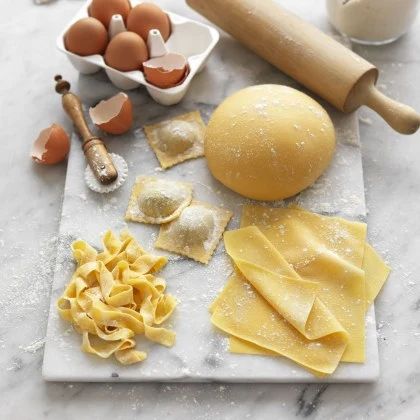If you have prepared pasta yourself, you’ll understand the euphoria associated with the process. It not only serves up fancier and enriched tastes, but one can also appreciate a great tradition of Italian people. Pasta is a main course in Italian families. There are special occasions like family dinners and holidays (like the feast of the scapular fish on Christmas Eve or the risen heavenly dove on Easter) where pasta is also served. Considering the customs, one benefits from the chance to make pasta in any country as one can harness Italian customs and span the globe through fusion cuisine, traditional recipes with Japanese ingredients for example.
Selecting Essential Ingredients For Different Pastas
We must know that when you prepare authentic Italian pasta, every detail really matters, including the quality of your ingredients. To be precise, use good-quality fresh ingredients to add the required flavours with depth and concentration. Here’s how to decide which ingredients to use.
Types of Flour to Use
One of the basic yet important factors in preparing real Italian pasta is using the right type of flour. The protein content of the flour, its texture, and gluten development all have a major influence on the final outcome of the dough and the behaviour of pasta during cooking.
Different kinds of pasta need different types of flour;
- Semolina Flour: Focuses on producing macaroni with a firm bite. Hence can be well utilised for coarse pasta.
- Tipo 00 Flour: This soft, fine-dominated flour is easy to handle, especially when making dry or silky pasta such as ravioli and tagliatelle.
- All-Purpose Flour: Once opened, can be applied to almost all forms of pasta, ideal for a beginner or someone who does not have a variety of specialised flours.
Importance of Using Fresh Eggs
Dough made with fresh eggs changes the taste and structure of pasta for the better. The use of fresh eggs will deepen the flavour of the dough helping to create a better-tasting pasta than the one available at the store. The use of fresh eggs will strengthen the dough, enabling it to be rolled and shaped with ease. This new elasticity results in better pasta shapes, which cook better and evenly, more so when sauces are added.
Herbs, Cheese and Oil For The Authentic Taste
The fundamental taste of the pasta chiefly lies in the sauces, herbs, cheese, and olive oil used. These not only enhance the taste of your pasta but also improve its authenticity.
Fresh Herbs:
- Basil: Unique to the tomato sauce – sweet with just a touch of pungency.
- Parsley: Relatively mild with a hint of freshness, typically used in rich dishes as a dressing.
- Oregano: Pungent, deep, and heated, perfect for enhancing red sauces and skewers.
Olive Oil:
- Extra Virgin Olive Oil: Drizzle over the pasta dishes that are ready after a thin layer of cold-pressed extra virgin olive oil is included or simple sauces like aglio e olio. Well, on the other hand, does not dominate other ingredients.
- Flavored Olive Oils: Oils flavored with garlic, herbs, or chili can also benefit the pasta by incorporating those oils into the dish as a finishing oil.
Cheese:
- Parmigiano-Reggiano: Known as the “King of Cheeses,” it’s essential for grating over pasta, risotto, and soups due to its sharp, nutty flavour.
- Pecorino Romano: A salty, tangy sheep’s milk cheese, perfect for dishes like Cacio e Pepe and Amatriciana.
- Mozzarella: Fresh mozzarella is key in dishes like Caprese salad and baked pasta dishes like Lasagna or Baked Ziti due to its creamy, stretchy texture.
- Ricotta: A soft, creamy cheese commonly used in stuffed pasta like Ravioli, Cannelloni, and Lasagna fillings.
Right Equipment For The Right Look
In pasta-making, it is necessary to use the right kind of equipment to have a normal and uniform process. It increases the level of precision relating to the dough helping in getting the required texture and thickness. Adopting appropriate tools further improves the procedure’s efficiency and alleviates such challenges as dough sticking or irregular shapes. Use of proper equipment, for instance, thins out the pasta professionally, making it appealing in regard to taste and presentation of the dish.

Below are some of the most important tools when making fresh pasta:
- Pasta Machine: Used to roll the sheets evenly to the required thickness and cut into any shape, including fettuccine or tagliatelle.
- Rolling Pin: Usually just a simple rolling tool for pasta dough and quite helpful in flattening out larger or more rustic dough shapes.
- Pasta Cutter: This is a wheel or knife which is designed to cut the dough made for Pastas like raviolis & pappardelle into different shapes.
- Bench Scraper: Good use of this device is when mixing and handling dough or even cutting divisions of the dough during the process.
- Drying Rack: It prevents fresh pasta from being solidified by sticky measures and also makes sure that the pasta retains the intended shape before cooking.
- Pasta Wheel: This is an ornamentation of the edges of stuffed pasta such as Ravioli.
- Dough Knife: It has a more basic purpose as it performs the function of removing excess pasta dough into strips or even pieces.
- Ravioli Mold or Stamp: It is a device where the outlines of ravioli are made, and the ravioli stamp is used for the more monotonous task of sealing the edges of ravioli.
Authentic Sauce Is The Key
Everything Seems to be Sweet, but No Actual Sauce, and Where Authentic Pasta Sauce is Concerned, There is No Deliquium.
Marinara:
This is a basic sauce made of tomatoes, garlic, olive oil, basil yes it’s all about tomatoes. This rapid way of cooking would not be complete without a sauce marinara which is a staple just like cooked tomatoes.
Pesto:
Composed mainly of fresh basil, pine nuts, garlic, parmesan, Evoo, and hand or salad oil blends of decent aromatic herbs of bright red colour. Basil pesto knot stands out in jar if nothing else, due to its views of rocky mountains and general marketing of pattern-bearing fortes but is raw and alive even better.
Alfredo:
Alfredo sauce is a thick and creamy sauce made with quality dairy, unlike the commercial alternatives, which are filled with fillers and have a synthetic texture. It uses milk, Parmesan cheese, butter, and cream to create a rich sauce that is delicious rather than good.
Making genuine Italian pasta at home is not only fulfilling creatively but indeed brings to life the tradition of pasta making. There is a high chance that using the right flour, fresh eggs, herbs, oils, and cheese, among other quality ingredients, you can make pasta that is very Italian. It doesn’t matter if you stick to traditional recipes or add some personalized touches; with homemade pasta, you can appreciate the exotic and delicious Italian cuisine.
For More Content Visit Tempestsphere






